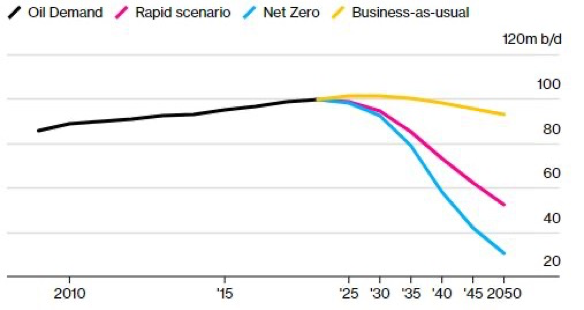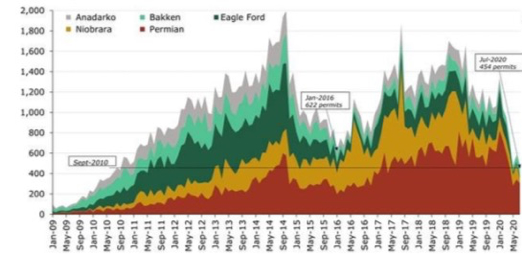
World oil demand has grown at a record pace since the bottom of the coronavirus-induced collapse in April. Global crude demand surged from May to July and now rests at 89 percent of prior year levels—compared to 78 percent in April.1
The coronavirus pandemic wiped out millions of barrels in fuel demand as countries locked down to contain the spread of the disease. Oil could see another demand shock as the International Energy Agency (IEA) sees a “treacherous” path ahead for the market. Oil consumption may never recover to pre-pandemic levels, and not just because of the pandemic itself but because of factors that have been at play before the coronavirus made itself known to the world.
Energy market participants have become increasingly anxious about a faltering economic recovery and wavering fuel demand. In their regular monthly forecasts last month, the three biggest energy authorities—the United States Energy Information Administration (EIA), the IEA and OPEC—predicted that it will take at least until 2022 for oil demand to recover to pre-crisis levels. IHS Markit expects demand growth to wane and plateau at 92 to 95 million barrels per day (b/d) (or roughly 92 percent to 95 percent of prior year levels) through the first quarter of 2021.1 At the same time, energy giant BP Plc said in its latest annual energy outlook report that the relentless growth of oil demand is over and that demand for oil will fall over the next 30 years.2
For 2020 as a whole, the IEA trimmed its outlook for worldwide oil demand growth to 91.7 million b/d. The international agency expects the recovery in oil demand to decelerate markedly in the second half of 2020. At 91.7 million b/d, demand has returned to its 2013 level. Looking ahead, the IEA said it expected worldwide oil demand to grow by around 5.5 million b/d next year, rising to an average of 97.1 million b/d in 2021.3
Jet fuel demand remains the major source of weakness. IEA revised data showing that in April the number of aviation kilometers traveled was down nearly 80 percent over last year, and in July the deficit was still 67 percent. With few signs that the picture will improve significantly soon, the IEA’s August forecast shows demand for jet fuel in 2020 will be 39 percent below the 2019 level.4
The IEA report came out shortly after OPEC cut its forecast for oil demand growth in 2020, citing a weaker-than-expected recovery in India and other Asian countries. OPEC said it expects the pandemic to reduce demand by 9.5 million b/d, forecasting a fall in demand of 9.5 percent from last year.5 The negative impact on oil demand in other Asian countries is projected to spill over into the first half of 2021.6
In July, OPEC+ (OPEC plus other oil producing allies including Russia and Kazakhstan) put historic supply cuts of 10 million b/d in place, but agreed to ease them to 7.7 million b/d beginning in August.7 If demand doesn’t come back, it is uncertain how long the OPEC+ group will be able to sustain cohesion and keep supply under control. In its most recent meeting in mid-September, OPEC+ did not announce additional output cuts.
Oil consumption may never return to levels seen before the coronavirus crisis took place, BP said in its annual energy outlook. The company laid out three scenarios for energy demand over the next 30 years, all of which predicted a decline for oil demand through 2050 as a result of the pandemic, stricter government policies and changes in consumer behavior.2
Even its most bullish scenario sees demand no better than “broadly flat” for the next two decades. In a “business-as-usual” situation, demand would recover but then flatline near 100 million b/d for the next 20 years. The “business-as-usual” projection assumes that government policies, technology and social preferences continue to evolve as they have in the recent past. Growth in China’s energy demand slows sharply relative to past trends, reaching a peak in the early 2030s in all three scenarios.8

Yet the “business-as-usual” scenario may not be the most likely one. Many governments have pledged increasingly aggressive environmentalist agendas that will see policies applied much more quickly. If these circumstances play out, oil demand will never return to pre-pandemic levels, according to BP. This means demand will have peaked in 2019, at a level of about 100 million barrels daily.2
Additionally, horizontal drilling activity in U.S. oil basins, which plummeted due to the pandemic, is unlikely to materially recover this year. Drilling permits, increasingly reliable indicators of future activity levels, dipped to a 10-year monthly low in July, with only 454 issued. July’s drilling permits number is the lowest since September 2010.9 Baker Hughes data shows that the horizontal oil rig count in the U.S. declined by 75 percent from the peak of 620 rigs in early March 2020 and has hovered around 150 to 160 since early July.9

Other global uncertainties remain in addition to coronavirus-related changes, including high debt levels, inflation, ongoing geopolitical risks, trade-related challenges, as well as the possibility of a hard Brexit. What is certain is that the oil market’s rebalancing remains a volatile situation and apprehension will endure so long as the world continues to deal with the coronavirus crisis.
References
- Oil and Gas Journal, IHS Markit: World Oil Demand Expected to Plateau Just Below Pre-Covid Levels, August 25, 2020.
- Oilprice.com, BP: Oil Demand Growth is Dead, September 14, 2020.
- CNBC, IEA Cuts 2020 Oil Demand Forecast, Sees ‘Treacherous’ Path Ahead with Rising Coronavirus Cases, September 15, 2020.
- Oil & Gas Journal, IEA Revises Down 2020 Oil Demand Forecast on High Covid-19 Cases, August 13, 2020.
- The Wall Street Journal, OPEC Extends Forecast for Decline in Global Oil Demand, September 14, 2020.
- Oil & Gas Journal, OPEC Revises Down 2020, 2021 Oil Demand Forecast, September 14, 2020.
- CNBC, Oil Could See Another Demand Shock, Adding to the ‘Extraordinary’ Destruction This Year, September 15, 2020.
- Bloomberg, BP Says the Era of Oil-Demand Growth Is Over, September 13, 2020.
- Oil & Gas Journal, New U.S. Horizontal Drilling Permits Hit 10-year Low, 2020 Activity Rebound Unlikely, August 11, 2020.

